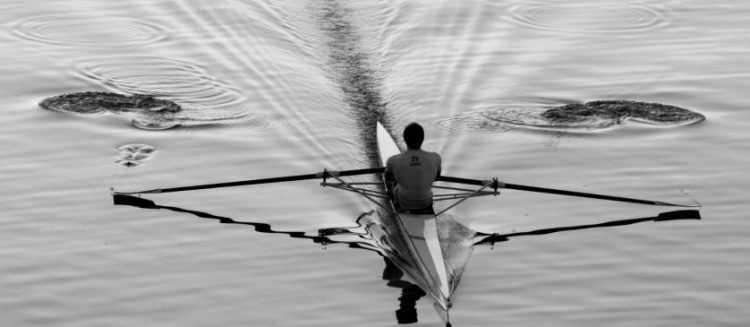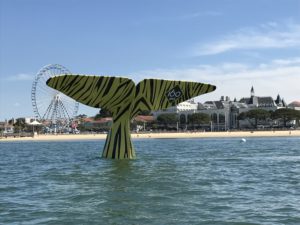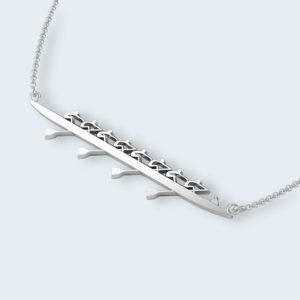Many other sports look to indoor rowing as a way of providing extra endurance sessions for their training programmes, but what can rowers take from other sports?
Cross-Training: What Why?
What is Cross-Training?
Cross-training is training in a sport or activity other than your main sport. If rowing is your main sport then you can cross-train by running, cycle, swimming or performing any other sporting activity.
Why Cross-Train?
There are several reasons, both physiological and psychological, why athletes should consider cross-training.
[Cross-training] takes advantage of the particular effectiveness of each training method, while at the same time attempting to negate the shortcomings of that method by combining it with other methods that address its weaknesses.
http://en.wikipedia.org/wiki/Cross-training
In physiological terms, cross-training is used to improve the performance of an athlete in one sport by borrowing methods and movements from other sports. Sports which involve repetition, such as rowing, put participants at risk of developing overuse injuries as muscles, tendons and ligaments are stressed over a period of time. Cross-training acts as supplementary training, aiming to reduce the risk of overuse injury of particular muscles or joints. Cross-training can allow rowers to improve their fitness levels without risk of developing lower back injuries, rib stress-fractures or wrist problems.
Rowing is a repetitive-motion sport where production of high levels of force is required. This kind of movement leads rowers to overdevelop certain muscles and to work joints in limited directions. The risk is that rowers become too specific. They may lose the ‘balance’ of their muscle groups and the strength and flexibility of joints, leading to injury when performing other activities. Cross-training works the body outside of the usual rowing motion to help to maintain strength and flexibility in non-rowing movements. The aim is to build a more robust athlete and lower the risk of future injury keeping a rower off the water.
Not only can cross-training be used to help prevent injury but also to rehabilitate athletes during recovery. Rowers with upper body injuries can maintain their fitness levels through sports such as cycling or running which isolate the injury while still working the lower body and the cardiovascular system.
A change is as good as a rest.
In psychological terms, cross-training provides something different. Even the most enthusiastic rowers will tire of long ergo sessions over the winter. Cross-training can alleviate the boredom of the winter training programme. While sessions on the rowing machine also help to improve technique, much of the time spent in these sessions is on developing a rower’s fitness. Similar fitness gains can be found by substituting some of these sessions for other sports. This gives rowers a new activity to challenge themselves with and helps to keep the ergo sessions from becoming routine and repetitive.
We’re not all professional rowers and sometimes real life can get in the way of our ideal training programme. When work or lifestyle constraints mean you can’t get to the boathouse, or find a rowing machine, cross-training comes into its own. Activities such as running require virtually no equipment and can be done almost anywhere. Can you save time in your day by commuting by bike and squeezing in a cycling session when you’d normally be driving? By using some imagination and whatever you find around you it’s possible to follow a demanding training programme despite a busy schedule.
Planning for Cross-Training
Each potential cross-training activity will have benefits for rowing as well as potential problems. Some activities will be relevant throughout the season, while others may be best used during pre-season, winter or competition periods.
When choosing to cross-train, make use of activities which are easily available. Build cross-training into your training programme to ensure that you get the right benefits at the right time. Keep the focus on rowing. Remember that cross-training should supplement your rowing and help to improve strength, fitness, flexibility and robustness; even a little will help.
Cross-Training Activities
Swimming
It often only becomes part of training during a particularly bad sculling session, but swimming can provide many physiological benefits for rowers. It is a no-impact sport and develops great endurance as well as generally improving upper body and trunk strength.
Benefits:
- Cardiovascular Endurance through increased lung capacity
- Shoulder and Trunk Strength Conditioning
- No Impact – Good for developing versatility and managing joint injuries
Issues:
Softens Hands – if you’re prone to blisters don’t swim more than once a week
See our ‘Rowing Blisters and Skin Injuries’ eBook for more advice.
Most Useful:
During winter to build a good base fitness when it may be too dark outside for other activities (swimming pools are usually warm too!)
Cycling
Cycling is used by a lot of rowers to complement their training because the two sports share use of the muscle groups in the legs. Cycling can be great for developing fitness and endurance. Indoor cycling on a stationary bike or turbo trainer is useful when training through upper body injuries or during icy winter weather.
The GB Rowing Team go on at least one cycling camp per season, usually at moderate altitude. Read about their typical day on cycling camp in Annie Vernon’s blog.
Mahe Drysdale has used cycling a lot in recent seasons to reduce the amount of time he spent in the boat or on the ergo when suffering from arthritis.
Drew Ginn has been very involved in cycling and is a keen advocate of what rowers can learn from the sport.
Benefits:
- Endurance
- Leg Strength Conditioning
- Core Stability
- Good for managing upper body injuries
-
(Tip: Use mobile apps like Strava to log monitor sessions)
Issues:
- Tight Hamstrings – stretch them after a cycling session
- Stay Safe – Wear a Helmet, Use Good Lights in the Dark, Be Aware in Traffic
- Equipment Needed (but for cross-training any bike will do)
- (Tip: Stationary Bike, Turbo Trainer or Spin es for when the weather is bad)
Most Useful:
All year round. Substitute some of your commutes for cycle-commutes to maximise training time.
Running
Running is probably the most accessible cross-training activity for rowers. It requires no facilities or extra equipment other than a pair of running shoes. Running is a great way of quickly improving fitness and monitoring your progress. You can add extra activities for a greater challenge; Princeton show us how it’s done
Be careful if you have knee or ankle problems; due to its high-impact nature running can develop or aggravate joint injuries. Off-road running, treadmills or elliptical trainers are more gentle.
Benefits:
- Endurance
- Leg Strength
- Weight Management
- Good measure of fitness (repeatable tests)
- Needs no extra equipment (cheap!)
- (Tip: Use mobile apps like Strava to log monitor sessions)
Issues:
High Impact – take it gently at first and switch to lower impact alternatives if problems develop.
Most Useful:
Pre-Season for quick fitness gains.
Winter for no-nonsense training on dark evenings.
Best to avoid during pre-competition competition phases due to risk of injury.
Swim/Bike/Run…All Three? – Triathlon
Rebecca Romero has taken to competitive Triathlon events and writes about her experiences of the sport on her blog.
Triathlon probably demands too much time to really work for current rowers, but is a popular cross-over sport and could provide a new challenge after the major spring and summer races are over.
Benefits:
- Huge Endurance gains
- Lots of challenges
Issues:
- Time Demands
Most Useful:
- Post-Season/Pre-Season
‘Alternative Triathlons’ are a great way of kick-starting your rowing season and building club spirit. Princeton, again, have this to offer
Cross-Country Skiing
The GB heavyweight men used to head up to the mountains for a cross-country skiing training camp each winter. The sport is considered the best form of exercise for developing fitness as it is a full-body workout with low impact and usually performed at altitude.
“Our competitive instincts and enthusiasm made us ideal pupils for the first few days. Then a little knowledge became dangerous. As soon as we could move, racing was the only option. But being fairly fit and strong we soon built up speed that far outweighed our ability. Sharp bends and descents became littered with bodies, leaving the Olympic cross-country skiers wondering why their ski route was covered in craters.”
James Cracknell – The Telegraph, 2002 (Rowing: Taking slippery slope to the top)
Benefits:
Superb Endurance
Low Impact
Issues:
Requires coordination! (and snow)
Most Useful:
Winter (obviously), but try Roller Skiing for a snow-free alternative.
Circuits Conditioning (e.g. CrossFit)
Circuits, CrossFit and similar high-intensity bodyweight exercise sessions are great for improving athlete robustness and building fitness quickly in a team setting. Many clubs run circuit sessions in the autumn and winter to quickly build fitness and teamwork.
GRC Strength Conditioning Coach, Giles Houghton, explains the theory and benefits of the land training programme:
“Rowing is obviously a highly repetitive motion, and too often I have seen land training programmes revolve solely around long ergs and building the muscle groups used in the stroke – so plenty of dead lifts, squats, bench pulls. Given what we know in modern sports science and sports psychology we can do better, because these programmes can be boring, don’t motivate people, and lead to injury by continually developing one side of the joint. Also, rowing at the club level presents a challenge because one month you can be doing a 6.8km head race, the next a 500m regatta – so we need to condition our athletes to be able to very rapidly adapt to different events.
“The new women’s programme at Gloucester Rowing Club assumes a mixed level of fitness to start and then builds a base aerobic capacity using a combination of CrossFit, military fitness, and team based dynamic movements. I am looking to improve CV and conditioning, make use of body confusion and get a bit of healthy competition going. Equally important, I want to get the squad to act like a team and to motivate each other to get through each session – at the end of the day they will only have each other to get through events such as Tideway.”
Benefits:
- Builds strength in joints in all directions
- Psychological ‘toughness’
- Teamwork
- Full-body workout
Issues:
- Easy to ‘over-do’ it, start gently
Most Useful:
-
Autumn Winter to kick-start fitness and build your squad’s team attitude.
Plyometrics
Plyometrics involves short, fast and powerful movements to develop the speed of movement and power in sports. It is useful for improving robustness and versatility as well as a multi-directional strengthening of joints. Many gyms now run es in Plyometrics.
Benefits:
- Develops power
- Reduces Risk of Injury
- Fitness
Issues:
- Needs to be taught to be most beneficial
Most Useful:
-
Pre-Competition to gain extra power and speed
Yoga/Pilates
While not necessarily working towards your strength or endurance, yoga and yoga-related exercises improve flexibility, core strength and balance. This type of training will allow rowers to achieve longer and more powerful positions in the boat with greater ease and comfort. This means power can be better applied. Improved joint strength and flexibility, again, helps to develop more robust rowers and decrease the risk of injury.
The GB Rowing Team are big believers in the benefits of yoga.
Rowperfect sells a yoga book specifically for rowers, Yoga for Rowers, in book or eBook format. The book provides instruction for simple yoga positions and how they relate to balance and power in each part of the stroke.
Benefits:
- Flexibility – improve the length of stroke
- Stability – improve balance (and applied power) throughout the stroke
- Application – improves awareness of movement
Issues:
-
None – yoga is for everyone.
Most Useful:
- All year round.
Whatever you choose, consider cross-training to provide something different, to support your rowing and to give you the edge this season.







